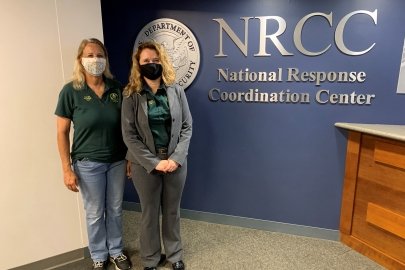During any disaster, whether it be a hurricane, wildfire, earthquake, or volcanic eruption, Department of Energy (DOE) emergency responders are prepared to work with their partners to aid in restoring power to those impacted. DOE’s Office of Cybersecurity, Energy Security, and Emergency Response (CESER) coordinates DOE’s response to hazards facing the energy sector.
When a potential major incident is identified, CESER begins preparing staffing plans. Working with FEMA, CESER dispatches responders to both State Emergency Operations Centers in threatened states and the FEMA Regional Response Coordination Center in the threatened region(s) in advance of the incident. Deployed responders coordinate with local counterparts and industry partners in the state to identify any issues that could potentially impact safe and efficient restoration. Meanwhile at the Department of Energy headquarters, CESER holds pre-disaster calls with state and industry partners to discuss preparations across the threatened area and to help identify any issues that may require federal support.
Once a disaster happens, on-the-ground responders provide subject matter expertise to help state and industry partners assess the disaster’s impacts to the energy sector, restore energy systems to full capacity, and identify any unmet needs that may require federal support or coordination. Throughout restoration, CESER holds daily calls with both the electricity and oil and natural gas sub-sectors to ensure there is a unified response effort, as well as coordination calls with the impacted states and various Federal partners. CESER also provides twice-daily situation reports and analysis of impacts to the energy sector, including potential regional and national impacts for large events.
For areas where restoration may be prolonged, responders work closely with local utilities, the affected state(s), FEMA, and the U.S. Army Corps of Engineers on temporary emergency power requirements. In the event a disaster exhausts local resources, deployed responders assist local officials and utilities with damage assessments and in identifying mutual assistance, equipment, and materials needs. The response team and FEMA then coordinate logistics with industry partners to assure materials, equipment, and additional mutual assistance are mobilized to provide timely support.
Following each response, CESER reviews response and recovery processes, procedures, roles, and responsibilities to evolve its emergency response organization capabilities in order to optimize future response and recovery support. For remote locations in particular, the recovery and restoration efforts are reviewed extensively, with issues of grid resilience and energy reliability taking precedence in future response planning efforts.
Reliable, resilient, and secure sources of energy are vital to the national and economic security of the United States. CESER works with its partners to maintain a reliable national energy infrastructure, applying lessons learned from the past to prepare for the storms and other natural threats of the future.
News and Updates
-
 June 1 marks the first day of hurricane season in the U.S., which runs until November 30. Prediction models forecast an active hurricane season in 2023, with around 2-3 hurricanes expected to reach Category 3 status.May 22, 2023
June 1 marks the first day of hurricane season in the U.S., which runs until November 30. Prediction models forecast an active hurricane season in 2023, with around 2-3 hurricanes expected to reach Category 3 status.May 22, 2023 -
 Throughout 2022, CESER’s ESF #12 response teams managed numerous rapid deployments and engaged in training and preparedness exercises to stay on top of best practices.February 3, 2023
Throughout 2022, CESER’s ESF #12 response teams managed numerous rapid deployments and engaged in training and preparedness exercises to stay on top of best practices.February 3, 2023 -
 DOE is ready to safely facilitate the restoration of energy systems while protecting public health as the 2020 hurricane season comes underway.June 1, 2020
DOE is ready to safely facilitate the restoration of energy systems while protecting public health as the 2020 hurricane season comes underway.June 1, 2020 -
 During COVID19, the Office of Cybersecurity, Energy Security, and Emergency Response expresses its appreciation for the essential workforce.May 18, 2020
During COVID19, the Office of Cybersecurity, Energy Security, and Emergency Response expresses its appreciation for the essential workforce.May 18, 2020 -
 Hurricane season in the Atlantic has officially begun.June 7, 2019
Hurricane season in the Atlantic has officially begun.June 7, 2019 -
 In early May, CESER conducted its seventh iteration of the ClearPath exercise series.June 3, 2019
In early May, CESER conducted its seventh iteration of the ClearPath exercise series.June 3, 2019 -
 Whether hurricanes, wildfires, earthquakes, or volcanic eruption, Department of Energy emergency responders were there.January 31, 2019
Whether hurricanes, wildfires, earthquakes, or volcanic eruption, Department of Energy emergency responders were there.January 31, 2019

